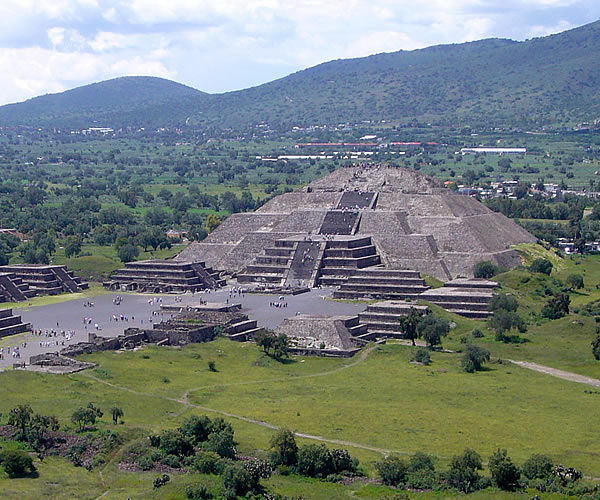
México City was founded on March 18, 1325 as Mexico-Tenochtitlan by the Nahua Aztec. The geography of the area was quite different at that time as it consisted of a series of lakes. The center of today's city was located on a small island on the middle of Lake Texcoco, which forced the Aztecs to build an artificial island with a series of canals to allow the growth of the metropolis. The canal's were later transformed into some of the principal avenues in México City. The Aztecs controlled the entire region and were able to extend their trade with almost all of Middle America.
This amazing civilization was dramatically altered by the arrival of the Spanish conquistador Hernán Cortés. Cortés attacked with 500 Spanish soldiers and more than 100 thousand indigenous warriors from the tributary people of the Aztec empire. After a 79-day siege, on August 13, 1521, the conquistador prevailed and overtook the city. The city of Tenochtitlan continued and grew, with more then 250 thousand inhabitants which rivaled the biggest European city Barcelona.
The city was rebuilt as the capital of the vice royalty of New Spain and continued to be an important hub of politics and culture. It was in this period that the phenomenal baroque Metropolitan Cathedral and the Basilica of Guadalupe were constructed. It was also a time of destruction as the Spanish demolished temples and buildings and the indigenous population was expelled from the city. Mistakenly, the Spanish acted as if ancient buildings and culture were no match for their more advanced society.
In 1810, the Mexican War of Independence was waged and the country struggled until 1821 to be free. México City was quickly declared the capital of the Mexican Empire. The nation became a federal republic in October 1824.
Border troubles with their neighbors to the North led to a war between the nations. The United States invaded México City on September 14, 1847 and eventually forced Mexico to cede the provinces of Santa Fe de Nuevo México and Alta California, what are today the States of California, Arizona, Colorado, Nevada, New Mexico and parts of Utah and Wyoming to the U.S. and recognize Texas as independent. This was formally recognized in the Treaty of Guadalupe Hidalgo, which was signed in what is now the suburb of the city of the same name. The invasion ended with a sad struggle at Chapultepec Castle in which, according to the legend, 13 young Mexican cadets fought helpless and outnumbered to keep the Americans from taking the symbolic castle.
For 3 decades the dictator Porfirio Díaz ruled the city and impressed a French influence on the region. The bronze Angel of Independence was built to celebrate the first century of the beginning of the War of Independence and is an example of that influence. Other examples include the Palacio de Bellas Artes and the expansion of Paseo de la Reforma à la Champs-Élysées.
Díaz was opposed after his long tenure in the Mexican Revolution in 1910. After a trying civil war, President Díaz was forced to resign and Francisco I Madero became the newly elected president. The times continued to be difficult as México City suffered from what has been called "La decena trágica" (The Tragic Ten Days). This included a series of events that transpired between February 9 and February 22, 1913, during the Mexican Revolution. The events culminated in a coup d'état and the assassination of President Francisco I Madero and his vice president, José María Pino Suárez. Organized by Victoriano Huerta in complicity with the United States Ambassador to Mexico Henry Lane Wilson, Huerta was recognized as the new leader of Mexico but social unrest remained just below the surface.
México City continued to grow and develop. An influx of immigrants from around the world made the city even more diverse and the city expanded incredibly. In 1950, the city had about 3 million inhabitants. By 2000, the estimated population for the metropolitan area was around 18 million. The city remains one of the largest and most dynamic cities in the world. In 2006, México City had a population of 19.2 million which made it the 3rd largest metropolitan area in the western hemisphere and the 3rd largest in the world by population. Besides São Paulo, México City is the only Beta global city with 8 points in Latin America.
Update 6/09/2008
Keep more of your money when transferring funds overseas!

If you want to move money abroad, from Mexico or to Mexico for example, Fexco provides efficient and secure global bank to bank transfers and bespoke payment solutions for both business and personal clients.
Why Fexco
Fexco provides a secure international money transfer service online or by telephone with bank beating fx rates and low fees. Specialises in high-value transfers.
Main characteristics
Fexco will help you to keep your overseas money transfer costs to a minimum.
| Margin | 0.6% |
|---|---|
| Regulator | FCA |
| Fee | £10 < £5K or Free > £5k |
| Mini | £1K |
| Ccy | All (130 currencies, incl ‘exotics’) |
| Services | Repatriation of funds, Property, Regular payments, High Value payments, spot, online, telephone. |
Get an online quote today
When you are ready to make your transfer, John and his team will be available to help you with better rates and an unrivalled service to make sure your funds are delivered securely and speedily.
